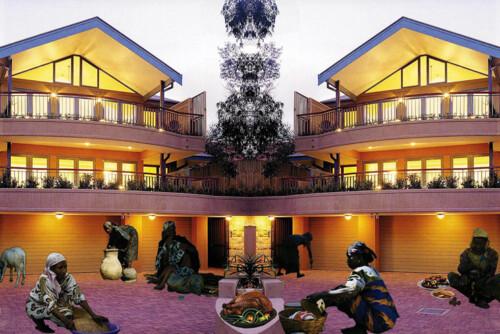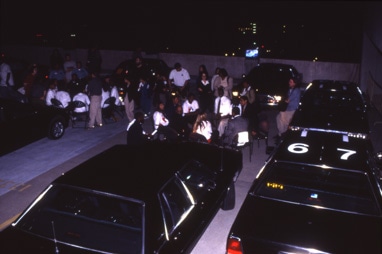Prolog
This is a story about the United States caught in a fabulated, on-going present that began some time ago. A time when some assemblage of things (technologies, sensibilities, flows of power and money, daydreams, institutions, ways of experiencing time and space, battles, dramas, bodily states. . .) started to articulate (and disarticulate) into (and out of) what we have come to call things like neo-liberalism, advanced consumer capitalism, and global empire. But these terms, and the five or seven or ten characteristics now routinely used to define them, do not begin to describe this long, still unfolding, moment we find ourselves in. There are the innumerable other things that are happening that remain unrecognized and ungathered by the concepts. And there is the active generativity of all things in a state of emergence that makes them fugitive, shifting, opportunistic, polymorphous, indiscriminate, aggressive, dreamy, unsteady, practical, and unfinished in their very surge to create ways and spaces for realization. Even as we pay them homage as the new really real and claim to know them, they are drifting into other realms and rubbing shoulders with other practices, seduced by any hint of movement. They go to eccentric or marginal or otherwise animated places where something is not yet captured by business as usual. This is certainly not to say that these things don’t have real power; rather, it is to say that power, or force, is constituted by its impacts in all their particularity.
The story is written as a cabinet of curiosities designed to incite. Rather than seek an explanation for things presumed to be known, it proposes a form of cultural and political critique that side steps and drifts, looking for rogue vitalities in bodily agitations, modes of free-floating fascination, the secret life of the senses, and any other sites of collective excitation that emerge momentarily into view from the seemingly insignificant and unrelated practices of ordinary living. Its obsession is with the state of emergence itself and its moments of blockage, retreat, ambivalence, or exhaustion. It tracks lines of force as they emerge in moments of shock, or become resonant in everyday sensibilities, or come to roost in a stilled scene of recluse or hiding. It asks how people, individually and collectively, are quite literally charged up by the sheer surge of things in the making. It presumes a “we” – the impacted subjects of a wild and twisting assemblage of influences – but it also takes difference to be both far more fundamental to cultural life and far more fluid than models of positioned subjects have been able to suggest.
The objects of the story, then, are emergent vitalities of all kinds that raise their heads, or dissipate, or get submerged on the charged border between the public and the private and turn the very border itself into a strange dance of spaces in flux. They are not the kind of things you can get your hands on, or wrap your mind around, but things that have to be literally tracked across seemingly disparate domains of bodies, discourses, laws, loves, and labors. They are what Sian Ngai (2001) calls bad examples: not perfect representations of an ideology or structure at work in the real world, but actual sites where forces have gathered to a point of impact to instantiate something. They are not things gathered under the sign of meanings or types but radical singularities with particular texture and density, hybridized mixes of things, flirtations along the outer edges of a phenomenon, or extreme cases that suggest where a trajectory might lead if it went unchecked. They are not representations at all but constitutive events and acts that animate and literally make sense of cultural forces at the point of their affective and material emergence. More directly compelling than ideologies, and more fractious, multiplicitous, and unpredictable than representations, they are moving targets.
This story, then, is not an exercise in representation, or a critique of representation, but an effort to do something else instead. It is not trying to present a final, or good enough, story of U.S. culture but instead to evoke the vitality of things. It tries to drag things into view, to follow lines of association, and to mimic felt impacts and half-known effects as if the writing were itself a form of life. It talks to the reader not as a trusted guide carefully laying out the perfect links between theoretical categories and the real world but as a subject caught in the powerful tension between what can be known and told and what remains obscure or unspeakable. It is not in search of an answer; its thoughts are speculative and its questions the most basic: what’s going on?; what floating influences now travel through public routes of circulation and come to roost in the seemingly private domains of hearts, homes, and dreams?; what forces are becoming sensate as forms, styles, desires, and practices?; what does it mean to say that particular events, strands of affect, and lines of intensity generate impacts?
It is not normative. It does not try to evaluate things as finally good or bad and far from presuming that meanings or values run the world, it is drawn to the place where “meaning” per se collapses and we are left with acts and gestures and immanent possibilities. Rather than try to pinpoint the beating heart of its beast, it tracks the pulses of things that cross each other, come together, fragment, and recombine in some new surge. It tries to cull attention to the affects that arise in the course of the perfectly ordinary life as the promise, or threat, that something is happening – something capable of impact. Whether such affects are feared or slavishly romanticized, subdued or unleashed, they point to the generative immanence lodged in things. In them, images touch matter. Far from the named “feelings” or “emotions” invented in discourses of morals, ideals, and known subjectivities (leave that to Hallmark and The Family Channel), they take on a shape in the surge of intensity itself. They give pause, if only for a moment.
This is a story about public circulations in moments of vital impact.




